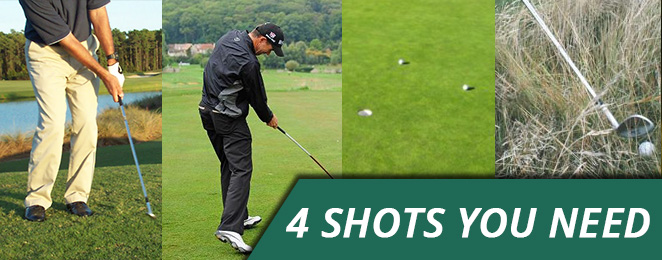More often than not people get obsessed with the tiny details of their golf swing and never really start to focus on their game.
Fortunately that won’t be you if you use some of your practice time on each of following four shots. These are the golf shots that hold your game together and keep your scores low.
Shoot Low Scores
Have More Fun
Sign up for our free email newsletter (Good at Golf Academy). It is jam-packed with the best golf instruction insights: Including “Road to Scratch“, “Long Drive Champion Secrets“, “Consistency Blueprints“ and “The Big Lesson From the Lesson Tee“.
[mailpoet_form id=”3″]Yes, it’s completely free.
Join hundreds of other happy golfers or read more about what’s inside
And despite all the fuss about the longest drive or nearest to the pin ego trips – the game of golf is still about who has the lowest score after 18 holes?
If you can focus your practice time equally on each of these shots I guarantee you that your scores will go down.
If you read through each one of them you’ll realise why.
These golf shots help you to eliminate penalty strokes (from out-of-bounds or lost balls), three putts and missed chipping opportunities – which are the worst enemies of all golfers.
First Shot To Practice: Greenside Chip Shots
If you are able to chip the ball comfortably into a three-foot circle around the hole your up and downs suddenly get a lot easier. With proficient chipping around the green you don’t have to worry too much if you miss your tee shot or your approach.
Usually practicing this shot makes a day and night difference on the overall score.
Always (and with that I mean always!) practice your greenside chipping when you are out to work on your game.
This skill has as much to do with touch and feel as it has to do with technique which is why you want to practice this shot at least a little bit whenever you have the chance.
The most important thing when you practice this shot is to vary your distances and lies. Practice from the rough, from a tight lie, from a good lie, close to the fringe, a couple of feet away etc.
If you do this regularly you gain the proficiency and experience to approach every up and down with confidence.
Here’s a great video by Mark Crossfield explaining the basic technique of a greenside chip. He makes it quite clear that its most important to chose the shot that’s easiest to you. Which usually is the shot where the ball is the least time in the air.
Second Shot To Practice: Tee Shots
Go figure, huh? But wait let me explain with a question: What’s a good tee shot to you?
Well, in reality it’s anyone you can find. And that’s not even a joke. Most mid- to high-handicappers don’t play to their capabilities and take driver just because they have it in the bag. Or they take the same club on every hole to tee off not even thinking about what lies ahead of them.
If you want to play for the lowest score you must keep your ball in play – period!
The fairway is narrow with trouble and out-of-bounds to the left and right? Suck it up and take a mid-iron.
Never risk a penalty stroke because of your big ego.
If you struggle with your driver but there’s enough space so you can hit it 2 fairways over – go for it bubba. The distance gained will make up for the angle of your second shot if you hit it off-line.
But by all means do anything you can to avoid penalty shots!
Never forget that golf is a game of percentages. Sometimes you hit miracle shot and sometimes you mess up the easiest thing in the world. Don’t let that fool you. If you want to play for a low score always opt for the shot with the highest probability for your skillset.
How To Practice Your Tee Shots
The next time you are on the range imagine each and every tee shot you need to hit on your golf course.
Think about your strategy and club selection to keep the ball in play. Take your basic shot shape (left-to-right or right-to-left) and potential trouble sources into consideration.
Then when you tee it off stick to your plan no matter what.
Even if you get some funny looks from your buddies don’t change what you’ve prepared for. When all is said and done you can rub your scorecard into their faces. ;-)
From a technique standpoint it’s always a good idea to experiment with strike ideas to master your driver.
That means just trying to hit the ball on different parts of your club face (preferring heel or toe) instead of focusing on certain positions or angles. Here’s another video by Mark Crossfield where he explains this idea:
Third Shot To Practice: Three- And Six-Foot Putts
The three- and six-foot range are the most important distances when it comes to putting.
Here’s often decided whether you can convert your up and down or you’ll have to leave with a bogey or worse. Three- and Six-Foot putts are key distances you need to be confident with and you can only gain this confidence through deliberate practice and experience.
So before each round of golf or whenever your decide to practice your putting don’t forget to do your three-footers and six-footers.
How To Practice Your Putting
Practicing your putting stroke is usually the easiest thing to do. You can even practice in the comfort of your own home.
There are a million and one drills which basically all teach the same thing: A feel for speed and distance, a proper stroke and being able to read the green.
Some of my favourite drills are explained in the following video. Practicing putting can be cumbersome and boring but these drills show us that it doesn’t have to be that way.
https://www.youtube.com/watch?v=1EHshPWZ_KU
A Book Recommendation When It Comes To Putting
If you really want to know everything there is to know about putting there is one book you should check out. Dave Pelz’s Putting Bible – The Complete Guide to Mastering the Green leaves no stone unturned when it comes to putting.
I mean, this guy is obsessed with the topic and will answer a lot of questions you don’t even think about in the first place.
E.g. in a tournament there will usually develop a small hill (“doughnot”) around the hole over time.
Just because people are doing most of their steps on the green when they are near to the hole. The book can be lengthy at times but gives you enough good ideas to think about – highly recommended.
Fourth Shot To Practice: Trouble Shots Out Of The Rough
The funny thing is that most amateurs are quite proficient with these kind of shots. Just because they practice them involuntary when they are out on the golf course. Nevertheless you shouldn’t go with your gut when you find yourself in the rough or another tough spot.
By practicing difficult lies and trouble shots you can save your score more often than not.
If you find yourself in heavy rough it’s usually the best option to pop it out onto the fairway with a relatively save chip shot. But you should also practice a shot that helps you gain at least a little distance. This can be useful when there’s no trouble ahead of you.
In the following video Piers Ward and Andy Proudman explain how to realise such a shot:
The Art Of Scoring Low
There you are. These are the four shots you need to focus your practice time on if you want to shoot your lowest score in your next round.
Do you practice these already on a regular basis? What shots are essential to keep your score low, in your opinion?
Let me know in the comments section or on twitter or facebook.




Leave a Reply